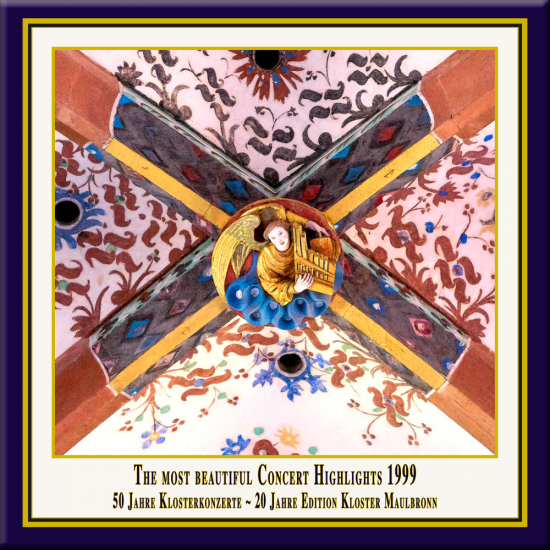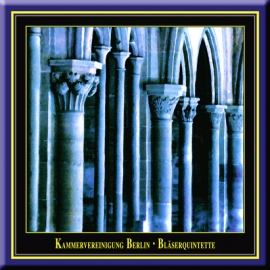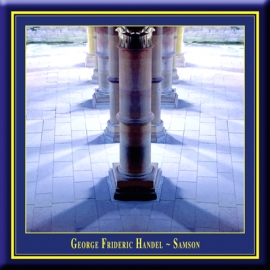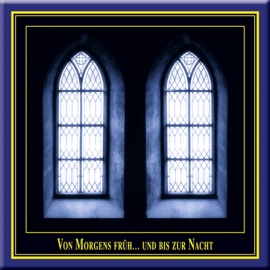Vol. 02: The most beautiful Concert Highlights 1999
Track
The most beautiful Concert Highlights
from Maulbronn Monastery 1999
The 50th Anniversary of the Maulbronn Monastery Concerts
Anniversary Series, Vol. 2
Highlights from:
Franz Schubert: String Quartet No. 14 in D Minor, D. 810 "Death and the Maiden" (July 3, 1999)
Franz Danzi: Wind Quintet in G Minor, Op. 56, No. 2 (September 4, 1999)
George Frideric Handel: Samson, HWV 57 (September 25 & 26, 1999)
The Choral Music Release: "The Tradition of the Liturgy of the Hours" (October 1999)
Live recordings from the church of the UNESCO World Heritage Site Maulbronn Monastery
HD Recording · DDD · Duration: c. 100 Minutes
Digital Album (here: MP3/320kBit/sec.) · 23 Tracks · incl. Digital Booklet
MP3 Album
320 kBit/sec.


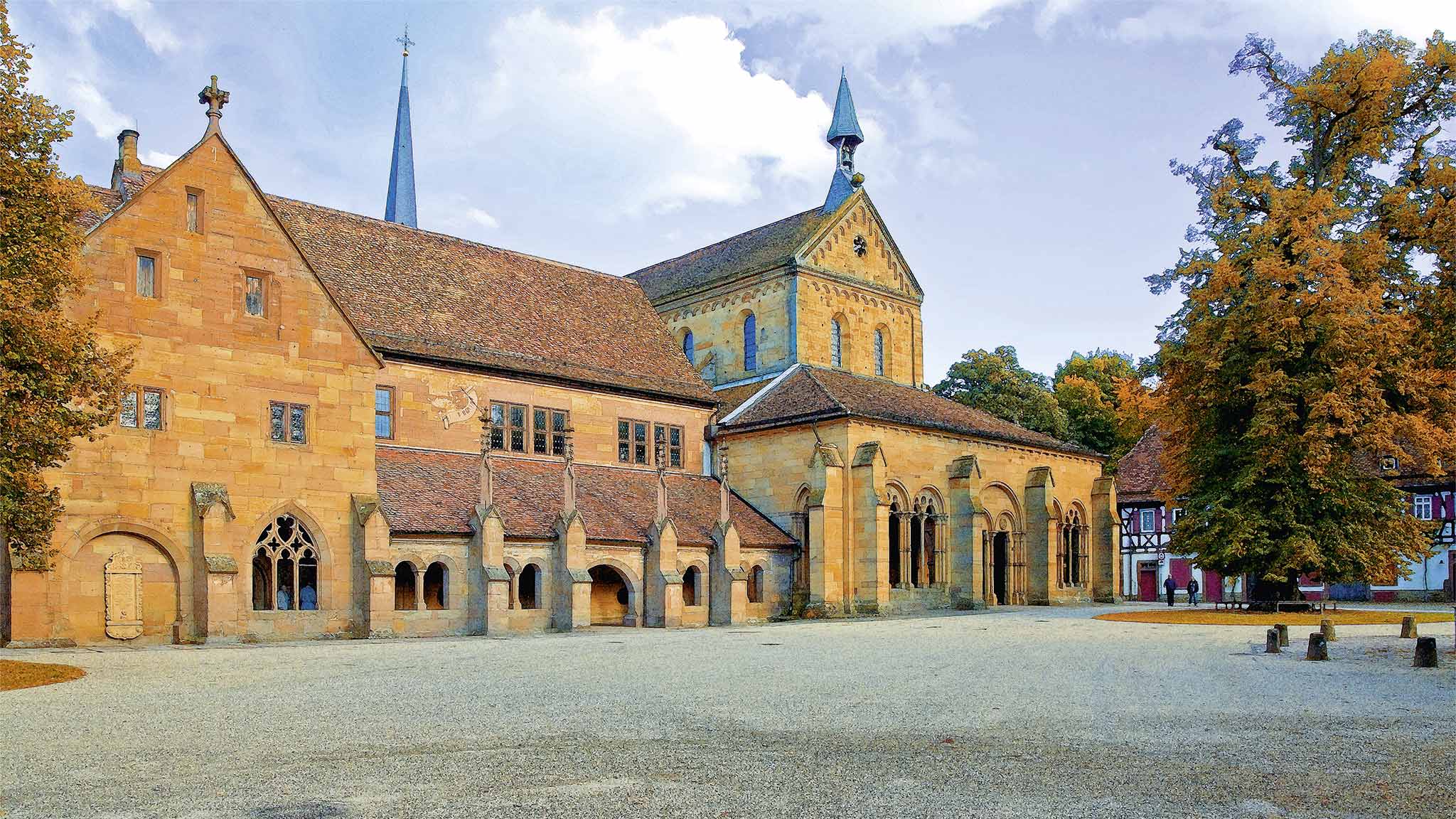
W
e have been documenting for 20 years the concerts at the UNESCO World Heritage Maulbronn Monastery. The concerts supply the ideal conditions for our aspirations. It is, above all, the atmosphere of the romantic, candle-lit arches, the magic of the monastery in its unadulterated sublime presence and tranquillity that impresses itself upon the performers and audience of these concerts. Renowned soloists and ensembles from the international arena repeatedly welcome the opportunity to appear here - enjoying the unparalleled acoustic and architectural beauty of this World Heritage Site, providing exquisite performances of secular and sacred music, documented by us in our Maulbronn Monastery Edition.
Josef-Stefan Kindler & Andreas Otto Grimminger, K&K Verlagsanstalt
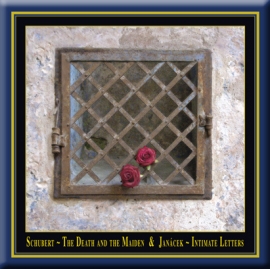
The String Quartet No. 14 in D Minor, D. 810 "Death and the Maiden" by Franz Schubert (1797-1828)
"Der Tod und das Mädchen" ("Death and the Maiden") by Franz Schubert gives us dramatic, passionate elation paired with an alarmingly serene wisdom. It was composed during Schubert's late phase (1826-28), which also includes such works as the song-cycle Winterreise ("A Winter's Journey"). Schubert's dance of death, based on the poem by Matthius Claudius poem, inspires few clear moments of comfort and confidence, and then only in a major key variation and in the Trio. There is nothing programmatic about it, even though the listener is granted considerable insight into Schubert's frame of mind in his later years.
The Wind Quintet in G Minor, Op. 56, No. 2 by Franz Danzi (1770-1827)
Franz Danzi, a contemporary of Beethoven, is the son of the Italian cellist Innocenzo Danzi, a member of the famous Mannheim court orchestra under Johann Stamitz. Already at the age of 15, Franz Danzi joined the orchestra as cellist. In 1798, after spending several years traveling with his wife, the singer Margarethe Marchand, to other European countries, Danzi was appointed vice conductor to Munich, where he premiered for example his opera "Iphigenie in Aulis". From 1807 to 1812 Franz Danzi worked as a court conductor and teacher of the Royal Institute of Art in Stuttgart, before he followed a call to Karlsruhe in 1812, where a new court theater was built in the classicist style shortly before. Under his leadership in Karlsruhe he conducted Weber's "Freischütz" as well as works by Mozart, Beethoven and Cherubini. The wind quintet in g minor, op. 56/2, was written during Danzi's time in Karlsruhe. Like the other two works of op. 56, this quintet is dedicated to his composer colleague Anton Reicha, who lived in Paris during that time. As with all of his wind quintets, Danzi strictly uses here to the four-movement sequence. A particular focus lies on the minuet. It has a remarkably fast tempo and has stripped the last bond to the typical court-dance-movements. In addition, there is room for a trio with customary folk music intonations.
Samson by George Frideric Handel (1685-1759)
Immediately after the "Messias", which was created within the 24 days between august, 22. and september, 14. 1741, Händel started to compose "Samson." At october, 29. 1741 he finished the last act, which means that those two biggest oratories, the "Messias" and "Samson," came into being within ten successive weeks only. Samson's dramaturgical fundament comes from the book "judges" of the bible. John Milton, England's most important baroque poet, has formed his epos "Samson Agonistes" by following freely the outlines of the bible. Newburgh Hamilton transformed it for Händel's oratory. It descibes the betrayal, the remorse and the victory of Samson, the israelean army commander, whose power grew with his hair, as the legend tells us. The work starts one year after the capture and blinding of Samson, when the priests of the pagan god Dagon are celebrating their greatest triumph. In his last struggle Samson, accompained by his father Manoah and his friend Micah, has to stand the temptations of the seductress Dalila and the giant Harapha, which are both followers of god Dagon and his priests. When his strenghs returns, Samson smashes the pillars of Dragon's temple and buries the enemies and himself under the rubble. Come, come and liter your moaning now, for our hero, Samson, died as Samson. In death and life winner, he gave ruin to our enemies, never ending glory to himself.... This live recording of Samson is part of a cycle of oratorios and masses, performed in the basilica of Maulbronn Abbey under the direction of Jürgen Budday. The series combines authentically performed oratorios and masses with the optimal acoustics and atmosphere of this unique monastic church. This ideal location demands the transparency of playing and the interpretive unveiling of the rhetoric intimations of the composition, which is especially aided by the historically informed performance. The music is exclusively performed on reconstructed historical instruments, which are tuned to the pitch customary in the composer's lifetimes (this performance is tuned in a' = 415 Hz).
The Tradition of the "Liturgy of the Hours" (Liturgia Horarum)
The tradition of horary prayers (particularly Complet) is still cultivated for certain occasions today at the Evangelical Seminary, supporter of the cloister concerts and the Maulbronn Chamber Choir. It therefore stands to reason that the liturgical form of the horary prayers be transfused to a musical, clerical programme. Of course, it is not possible to feature the complete horary prayer texts as choir compositions. In such, the programme's concept is based on the adoption of integral liturgy components from every horary prayer by textually identical or paraphrased choir compositions. Each horary prayer contains an hourly text, a psalm prayer, and a canticle from the New Testament. The programme implies particular suspense by posing 19th century compositions vis-à-vis stylistically contrary 20th century compositions and monophonic orthodox cantos.
P
ublishing Authentic Classical Concerts entails for us capturing and recording outstanding performances and concerts for posterity. The performers, audience, opus and room enter into an intimate dialogue that in its form and expression, its atmosphere, is unique and unrepeatable. It is our aim, the philosophy of our house, to enable the listener to acutely experience every facet of this symbiosis, the intensity of the performance, so we record the concerts in direct 2-Track Stereo digital HD. The results are unparalleled interpretations of musical and literary works, simply - audiophile snapshots of permanent value. Flourishing culture, enthralling the audience and last but not least also you the listener, are the values we endeavor to document in our editions and series.
The concerts at the UNESCO World Heritage Maulbronn Monastery supply the ideal conditions for our aspirations. It is, above all, the atmosphere of the romantic, candle-lit arches, the magic of the monastery in its unadulterated sublime presence and tranquillity that impresses itself upon the performers and audience of these concerts. Renowned soloists and ensembles from the international arena repeatedly welcome the opportunity to appear here - enjoying the unparalleled acoustic and architectural beauty of this World Heritage Site, providing exquisite performances of secular and sacred music, documented by us in our Maulbronn Monastery Edition.
Andreas Otto Grimminger & Josef-Stefan Kindler, K&K Verlagsanstalt
Franz Schubert (1797-1828):
String Quartet No. 14 in D Minor, D. 810
"Death and the Maiden"
performed by the Amati Quartet:
Willi Zimmermann & Katarzyna Nawrotek (Violin)
Nicolas Corti (Viola) · Claudius Herrmann (Cello)
on July 3, 1999
1. I. Allegro [11:50] · 2. II. Andante con moto [10:33]
3. III. Scherzo: Allegro molto [3:39] · 4. IV. Presto [8:43]
Franz Danzi (1770-1827):
Wind Quintet in G Minor, Op. 56, No. 2
performed by the Berlin Chamber Consort (Kammervereinigung Berlin):
Iris Jess (Flute) · Gudrun Reschke (Oboe) · Alexander Roske (Clarinet)
Bodo Werner (French Horn) · Mathias Baier (Bassoon)
on September 4, 1999
5. I. Allegretto [3:46] · 6. II. Andante [4:31]
7. III. Menuetto allegretto [2:39] · 8. IV. Allegretto [2:37]
George Frideric Handel (1685-1759):
Samson
The English Oratorio HWV 57,
performed according to the traditions of the time
by the Maulbronn Chamber Choir
and the Monastery Baroque Orchestra,
conducted by Jürgen Budday
on September 25 & 26, 1999
Words by Newburgh Hamilton
9. Overture [4:21]
10. Act 1: This day, a solemn feast to Dagon held [0:35]
Recitative of Samson
Soloist: Mark Le Brocq (Tenor)
11. Act 1: Awake the trumpet's lofty sound [1:53]
Chorus (Priests and Worshippers of Dagon)
12. Act 1: Then long eternity shall greet your bliss
Joys that are pure, sincerely good [6:04]
Air of Micah
Soloist: Michael Chance (Countertenor)
13. Act 2: Return, O God of Hosts [13:36]
Air of Micah with Chorus of Israelites
Soloist: Michael Chance (Countertenor)
14. Act 2: With plaintive notes and am'rous moan [4:32]
Air of Dalila
Soloist: Sinéad Pratschke (Soprano)
15. Act 3: With thunder armed, great God, arise [2:59]
Chorus of Israelites
16. Act 3: Proceed we hence to find his body [0:40]
Recitative of Manoah
Soloist: Raimund Nolte (Bass-Baritone)
17. Act 3: A Dead March [3:20]
for Orchestra
18. Act 3: The body comes [0:51]
Recitative of Micah
Soloist: Michael Chance (Countertenor)
There shall all Israel's valian youth resort
Recitative of Manoah
Soloist: Raimund Nolte (Bass-Baritone)
19. Act 3: Let the bright Seraphim in burning row [2:58]
Air of Israelitish Woman
Soloist: Sinéad Pratschke (Soprano)
20. Act 3: Let their celestial concerts all unite [2:54]
Chorus of Israelites
Choral Music, A Cappella:
The Tradition of the Liturgy of the Hours
(Liturgia Horarum)
performed by the Maulbronn Chamber Choir,
conducted by Jürgen Budday
in October 1999
21. Laudate omnes gentes [3:28]
by Anonymous
22. Verleih' uns Frieden gnädiglich, WoO 5, MWV A 11 [1:41]
by Felix Mendelssohn (1809-1847)
23. Bleib' bei uns, denn es will Abend werden [3:31]
Evening Song (No. 3) from 'Geistliche Gesänge', Op. 69
by Josef Gabriel Rheinberger (1839-1901)
Sound & Recording Engineer: Andreas Otto Grimminger
Mastering: Andreas Otto Grimminger & Josef-Stefan Kindler
Photography: Josef-Stefan Kindler
Artwork & Coverdesign: Josef-Stefan Kindler

